'Halloween Ends' Shoots Itself In The Foot
- Oops!Something went wrong.Please try again later.
- Oops!Something went wrong.Please try again later.
- Oops!Something went wrong.Please try again later.
- Oops!Something went wrong.Please try again later.
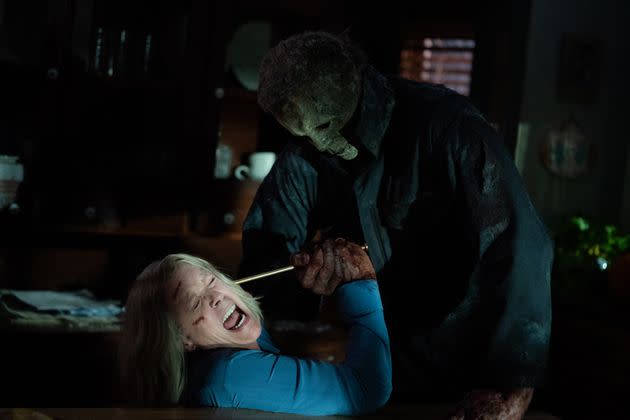
Laurie Strode (Jamie Lee Curtis) faces off against Michael Myers (aka The Shape, played by James Jude Courtney) one last time in "Halloween Ends." (Photo: Ryan Green/Universal Pictures)
Less than an hour into director David Gordon Green’s “Halloween Ends,” the franchise’s longtime and seemingly indestructible villain, Michael Myers (James Jude Courtney and Nick Castle), takes shape in the darkness of a hole beneath an overpass.
He’s unsteady and haggard. His signature mask is almost totally unrecognizable after enduring numerous explosions, gunshot wounds and other forms of vengeance since he made his debut on our screens in the inimitable 1978 original film. He’s now unfamiliar and even a little boring to watch.
The same can be said about “Halloween Ends.” You can tell it’s in the same family as the ’70s movie. It still takes place in the fictional town of Haddonfield, Illinois, Laurie Strode (Jamie Lee Curtis) remains, to Michael, the victim who got away, and the score, again by the franchise’s original co-writer and director, John Carpenter, continues to send chills down your spine.
And, of course, there’s Michael, the perennial boogeyman lurking in the shadows. But now the whole thing feels, as the title implies, like it should be put down for an eternal rest. The concept of the boogeyman — a silent, brooding figure manifested from anyone’s nightmares — has been an endlessly fascinating topic of discussion as the franchise has progressed.
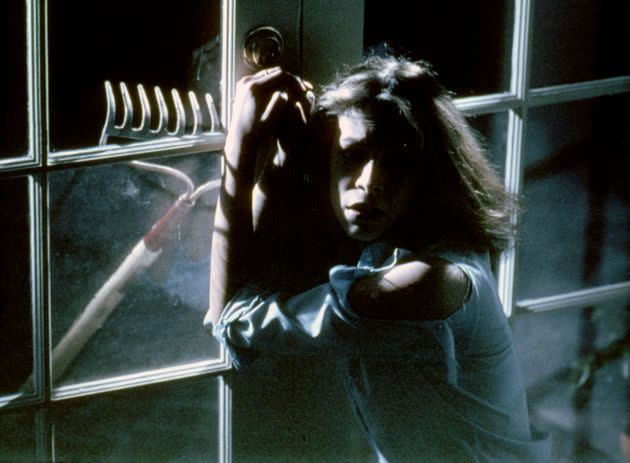
Jamie Lee Curtis as Laurie Strode on the set of 1978's "Halloween," written and directed by John Carpenter. (Photo: Compass International Pictures/Sunset Boulevard/Corbis via Getty Images)
But the last three films, including 2018’s “Halloween” and last year’s “Halloween Kills” — all helmed by Green — have clumsily been about a confrontation with trauma as a result of Michael’s violence. Or, as “Halloween Ends” attempts to ask: Is that type of evil more nebulous and dormant within each of us until it is awakened by a tragic circumstance?
That theory is a stretch and is potentially problematic in a way that’s similar to how the first few episodes of Syfy’s “Chucky” were arranged before the writers smartened up. But Green and screenwriter Paul Brad Logan seem, at least in the first half of “Halloween Ends,” determined to investigate this point.
And, to be fair, the opening sequence in “Halloween Ends” is pretty terrific, though it very much bites off the pristine opening sequence of the first “Scream” movie. It’s Halloween night, and the parents of a young boy are heading out to a party, leaving their son with babysitter Corey Cunningham (Rohan Campbell), a sweet, college-bound teen.
Upon their departure, an unsettling feeling immediately engulfs the spacious home as Green sets up a number of tricks to rattle us.
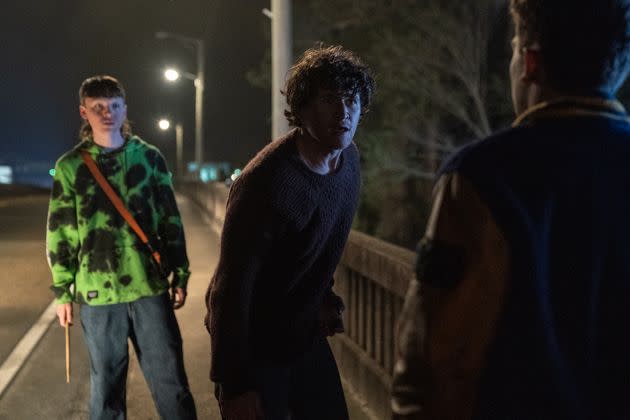
Town pariah Corey (Rohan Campbell, left) confronts his bullies Billy (Marteen) and Terry (Michael Barbieri) in "Halloween Ends." (Photo: Ryan Green/Universal Pictures)
Those include a large knife that goes missing from the kitchen counter, Carpenter’s “The Thing” playing in the living room and the note from the boy’s parents letting the sitter know he’s afraid of the dark. We’re watching for all these things to mean something in a very evil way.
Instead, a totally unexpected terror happens upstairs that results in the brutal accidental death of the boy at the hands of Corey. It arises from the babysitter’s own internal fears, but he is instantly branded a pariah in this small town.
From that intense ostracism and the bullying from the town punks, “Halloween Ends” ponders whether any old hurt person like Corey can put on Michael’s tattered mask and terrorize innocent people because he’s wracked with guilt compounded by being a social exile. Again, it’s a stretch.
And it takes away from a few critical questions posed by the franchise, an urgent one left dangling at the end of the 2021 film: How will Laurie exact revenge on Michael for killing her daughter in “Halloween Kills”?
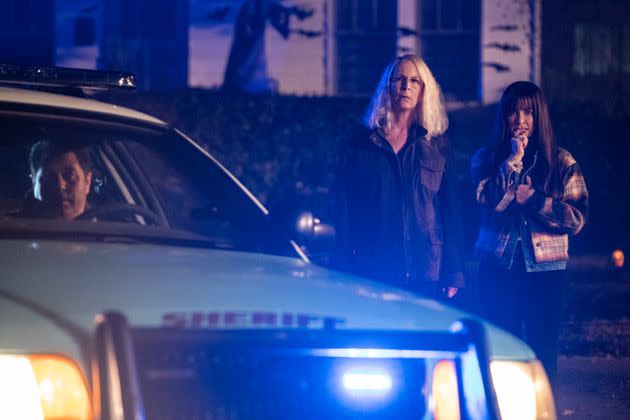
Laurie Strode (Jamie Lee Curtis) and fellow Michael Myers survivor Lindsey (Kyle Richards) meet a new evil in "Halloween Ends." (Photo: Ryan Green/Universal Pictures)
When you set up a film as the potential last one in a decades-long franchise, one immortalized with the help of Laurie and Michael, what any longtime fan wants to see most critically is a head-to-head — especially after the buildup about this being Curtis’ last time playing Laurie.
Instead, for the bulk of the film, we get a meandering meditation on a promising young man who goes dark, with a significant assist from Michael, because the world turned against him ― and why not. It’s a rudimentary premise, and a terribly grotesque one considering the pattern of young white men who turn violent because they feel the world owes them something.
That’s never really been what the “Halloween” franchise was about. Even at its lowest point, before this last trilogy at least, the fear was less tangible. Michael was always identified as the source of evil, but he could never truly be caught or killed.
He’s nightmarish in every sense of the word because you wonder at times whether he’s actually real — if it weren’t for the escalating body count. But Corey is pedestrian in a similarly intense way. It’s clear that the filmmakers are trying to make us think about what evil looks like, which strays too far from what makes “Halloween” so ghastly.
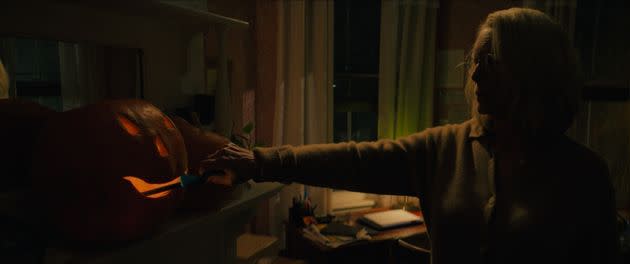
Laurie Strode (Jamie Lee Curtis) braces for another terrifying Oct. 31 in "Halloween Ends." (Photo: Universal Pictures)
Evil has been identified, and scarily we can’t catch it. Corey is mostly just in the way throughout the film. It’s Laurie, psychologically and physically battered and considered by her neighbors to be a magnet for terror in Haddonfield, that we care about. She’s lost her only child and now clings to her roommate and granddaughter Allyson (Andi Matichak) like she’s her lifeline.
“Halloween Ends” fumbles around themes of trauma and recovery through Laurie’s character. She’s paranoid (though with good reason, since Corey starts dating Allyson), lonely and emotionally unable to pursue a potential romance.
But none of that really works well here when Laurie is pushed to the margins in a story mostly reduced to being about a newfound psychopath rather than an amorphous villain.
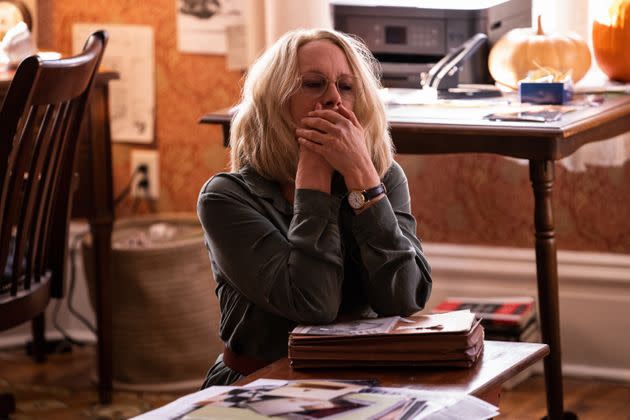
Laurie Strode (Jamie Lee Curtis) realizes there's a whole new terror in town in "Halloween Ends." (Photo: Ryan Green/Universal Pictures)
Green and his team are marginally cognizant that OG audiences of the franchise are here for this supposed final hurrah in Haddonfield. There are plenty of callbacks to the original film. Like, Laurie hiding out in a closet as Michael prowls her home, the knitting needles, the camera angle through the villain’s mask as he picks up a kitchen knife to kill a nagging older woman.
Those are fun to see re-created in 2022, even if they are ultimately meaningless. The times when Michael does kill, and when he and Laurie have their inevitable showdown, are thrilling. Both are now older (working with the flawed theory that Michael is real, or realer in this film than he has ever been), more tentative yet with as much rage as they had years ago.
The jump scares, though, are mostly less slick. When they’re good, they’re great — as are the expected “Are they really dead?” fakeouts. But generally? “Halloween Ends” is a bummer. And everything about it makes it seem like it’s willing to go. We should let it.
This article originally appeared on HuffPost and has been updated.
